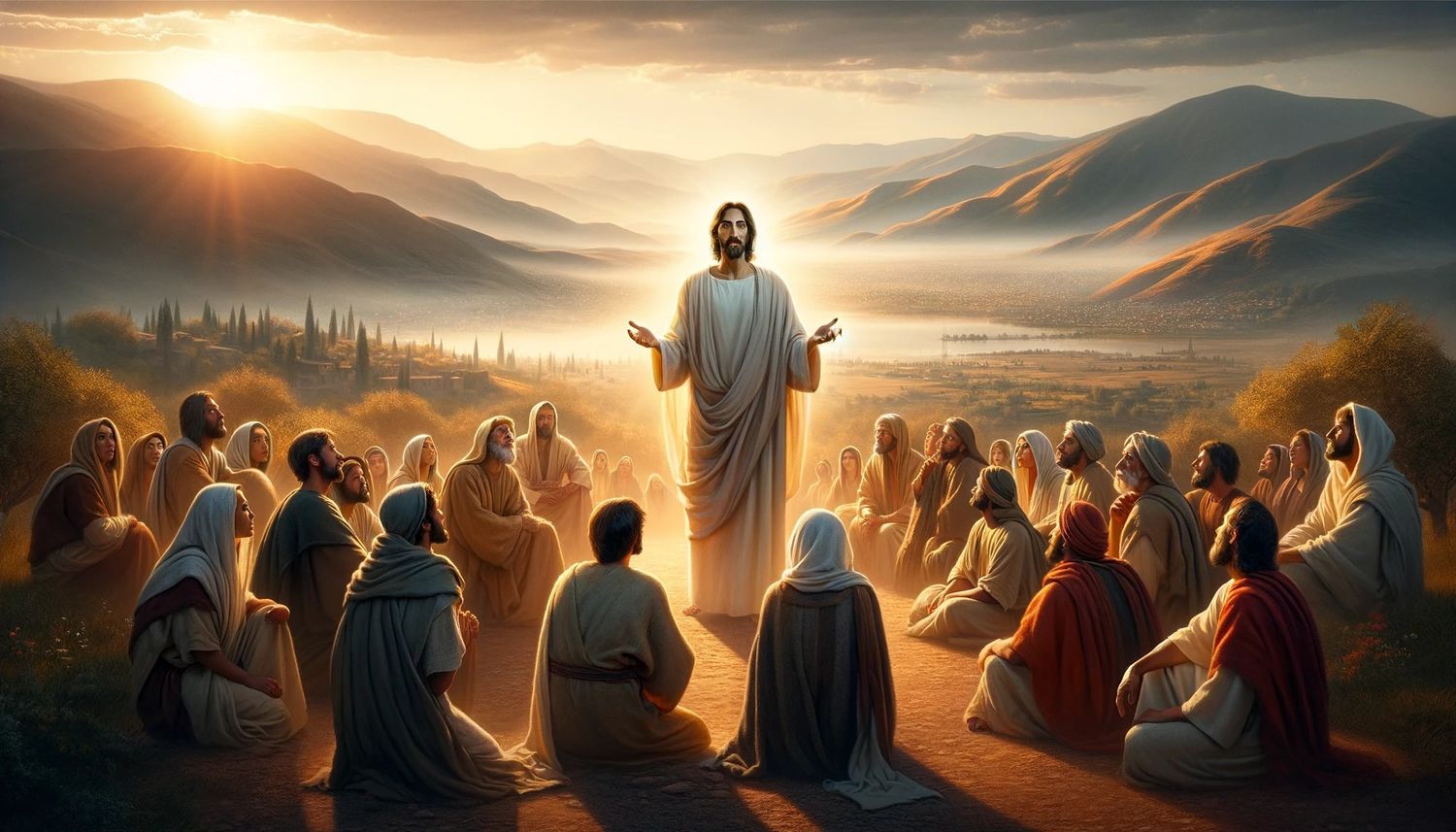Home>Christian Videos>Bible Stories>What Do The Gospels Tell Us About Jesus


Bible Stories
What Do The Gospels Tell Us About Jesus
Published: March 7, 2024
Peter Smith, Editorial Director at Christian.net, combines deep insights into faith, politics, and culture to lead content creation that resonates widely. Awarded for his contributions to religious discourse, he previously headed a major organization for religious communicators, enhancing dialogue on faith's societal impacts.
Explore the fascinating Bible stories about Jesus in the Gospels. Discover the profound insights and teachings they reveal about his life and mission. Unlock the timeless wisdom of the Gospels today!
(Many of the links in this article redirect to a specific reviewed product. Your purchase of these products through affiliate links helps to generate commission for Christian.net, at no extra cost. Learn more)
Table of Contents
Introduction
What Do The Gospels Tell Us About Jesus? The Gospels, which are the first four books of the New Testament, provide a comprehensive account of the life, teachings, and impact of Jesus Christ. These texts, written by different authors, offer unique perspectives on the central figure of Christianity. They are not only religious documents but also valuable historical sources that shed light on the cultural, social, and political context of the time. In this article, we will delve into the Gospels to uncover the rich tapestry of information they provide about the life and legacy of Jesus.
Read more: What Did Jesus Tell The Apostles To Do
The Historical Context of the Gospels
The Gospels were written during a period of significant historical and cultural upheaval in the ancient world. The Roman Empire held sway over the region, and the Jewish people were living under Roman occupation. This context is crucial for understanding the political and social dynamics that shaped the events described in the Gospels. The Roman influence, the Jewish religious landscape, and the interplay between various religious and cultural groups all set the stage for the life and ministry of Jesus as depicted in the Gospels.
The Gospels also reflect the diverse religious and philosophical currents of the time. Judaism, with its rich traditions and scriptures, provided the backdrop for Jesus's teachings and the early Christian movement. Additionally, the influence of Hellenistic thought and culture, which permeated the Mediterranean world, is evident in the language and concepts used in the Gospels. The interweaving of these various cultural and religious elements adds depth to the historical context in which the Gospels were written and helps modern readers appreciate the complexities of the era in which Jesus lived.
Moreover, the Gospels were written in the decades following the death of Jesus, a period marked by the spread of early Christianity. The authors of the Gospels were not only recounting the life of Jesus but also shaping the narrative to address the needs and concerns of their respective communities. This dynamic historical context influenced the way in which the Gospels were composed, as they sought to convey the significance of Jesus's life and teachings to their audiences.
In summary, the historical context of the Gospels encompasses the political, cultural, and religious milieu of the ancient Mediterranean world. Understanding this context is essential for interpreting the events and teachings presented in the Gospels and appreciating the enduring impact of Jesus's life and message.
The Birth and Early Life of Jesus
-
The Annunciation and Virgin Birth: The Gospels of Matthew and Luke provide accounts of the miraculous conception and birth of Jesus. According to these narratives, the angel Gabriel appeared to Mary, informing her that she would conceive a child by the Holy Spirit. This event, known as the Annunciation, signifies the divine nature of Jesus's birth. The Virgin Birth, as described in these Gospels, underscores the belief in Jesus as the Son of God and emphasizes his unique role in the salvation of humanity.
-
The Nativity and Bethlehem: Both Matthew and Luke recount the circumstances surrounding Jesus's birth in Bethlehem. The Gospels depict the humble setting of the Nativity, with Jesus being born in a manger, signifying his identification with the poor and marginalized. The visit of the Magi, as described in Matthew, and the appearance of angels to shepherds, as narrated in Luke, highlight the universal significance of Jesus's birth and the fulfillment of prophecies regarding the Messiah.
-
The Flight to Egypt and Return to Nazareth: The Gospel of Matthew recounts the flight of the Holy Family to Egypt to escape King Herod's decree to kill all male infants. This episode underscores the political tensions and the threat posed to Jesus's life from a young age. After Herod's death, the family returns to Nazareth, where Jesus grows up and is known as a carpenter's son. These early years in Nazareth provide insights into Jesus's upbringing and the formative influences that shaped his identity and mission.
-
The Presentation in the Temple: According to the Gospel of Luke, Mary and Joseph presented Jesus in the temple in Jerusalem, in accordance with Jewish law. This event symbolizes Jesus's consecration to God and foreshadows his future role as a spiritual leader. The encounter with Simeon and Anna, who recognize Jesus as the fulfillment of God's promises, adds to the significance of this early episode in Jesus's life.
-
The Childhood of Jesus: The Gospels offer limited information about Jesus's childhood and adolescence. However, the account of Jesus's visit to the temple at the age of twelve, as found in Luke, provides a glimpse into his early spiritual awareness and wisdom. This episode hints at the extraordinary nature of Jesus's identity and mission, even from a young age.
The narratives surrounding the birth and early life of Jesus in the Gospels serve to establish the divine nature of his mission, underscore his connection to the prophetic traditions of Judaism, and set the stage for his future ministry and teachings. These accounts lay the foundation for understanding Jesus's role as the embodiment of God's love and the fulfillment of ancient promises.
Jesus's Ministry and Teachings
-
The Inauguration of Jesus's Ministry: The Gospels depict the beginning of Jesus's public ministry with his baptism by John the Baptist in the Jordan River. This event marks the commencement of his mission to proclaim the arrival of the kingdom of God and to call people to repentance and faith. The baptism of Jesus, accompanied by the descent of the Holy Spirit and the voice from heaven, signifies the divine anointing and approval of his ministry.
-
Proclamation of the Kingdom of God: Central to Jesus's teachings is the proclamation of the kingdom of God. Through parables, sermons, and interactions with diverse audiences, Jesus conveys the transformative and inclusive nature of God's reign. His teachings emphasize the values of compassion, justice, forgiveness, and the radical love of God for all people. The kingdom of God, as articulated by Jesus, challenges societal norms and offers a vision of a renewed and reconciled world.
-
Ethical Teachings and Moral Imperatives: Jesus's ministry encompasses a profound ethical framework that addresses various aspects of human conduct and relationships. The Sermon on the Mount, found in the Gospel of Matthew, encapsulates key ethical teachings, including the Beatitudes, the call to love one's enemies, and the principles of prayer, fasting, and almsgiving. These teachings emphasize the inner transformation of individuals and the pursuit of righteousness and peace.
-
Healing and Restoration: A prominent aspect of Jesus's ministry is his acts of healing and restoration. The Gospels portray numerous instances where Jesus demonstrates compassion and power by healing the sick, restoring sight to the blind, and offering wholeness to those marginalized by society. These miraculous deeds not only reveal Jesus's divine authority but also symbolize the restoration of God's intended wholeness for humanity.
-
Challenges to Religious Hypocrisy and Legalism: Jesus's teachings often confront the religious authorities of his time, challenging their hypocrisy, legalism, and neglect of the weightier matters of faith. His criticisms of the Pharisees and scribes highlight the importance of genuine piety, mercy, and justice over mere adherence to religious rituals and regulations. Jesus's ministry calls for a deeper, authentic commitment to God and a compassionate engagement with others.
-
Inclusivity and Compassion: Throughout his ministry, Jesus demonstrates a radical inclusivity and compassion towards those on the margins of society. He engages with outcasts, sinners, and the socially marginalized, offering them dignity, acceptance, and the promise of God's grace. Jesus's actions and teachings challenge societal prejudices and affirm the intrinsic worth of every individual, regardless of their social status or background.
-
The Call to Discipleship and Service: Jesus's ministry includes the call to discipleship, inviting individuals to follow him, learn from his teachings, and participate in the mission of the kingdom of God. The Gospels record Jesus's commissioning of his disciples to proclaim the good news, heal the sick, and embody the values of servanthood and humility. The model of servant leadership exemplified by Jesus shapes the ethical and relational dynamics of his ministry.
-
The Transfiguration and Revelation of Glory: The Gospels narrate the transfiguration of Jesus on the mountain, where his divine glory is revealed to a select group of disciples. This event underscores the transcendent nature of Jesus's identity and mission, affirming his unique relationship with God and the fulfillment of the prophetic promises. The transfiguration serves as a pivotal moment in Jesus's ministry, confirming his authority and the continuity between the law, the prophets, and his own ministry.
The ministry and teachings of Jesus, as depicted in the Gospels, present a compelling vision of God's redemptive purposes, the ethical imperatives of discipleship, and the transformative power of love and compassion. Jesus's ministry not only addresses the immediate social and spiritual needs of his contemporaries but also offers enduring principles for ethical living, social justice, and the pursuit of spiritual wholeness.
Miracles and Healings
-
Demonstrations of Divine Power: The Gospels abound with accounts of miracles and healings attributed to Jesus. These extraordinary acts serve as demonstrations of divine power, affirming Jesus's authority and the arrival of God's kingdom. The miracles encompass a wide range of phenomena, including the healing of physical ailments, the exorcism of demons, the control of natural elements, and the restoration of life. Each miracle underscores Jesus's unique role as the agent of God's redemptive work and the embodiment of divine compassion and mercy.
-
Signs of the Kingdom: The miracles and healings performed by Jesus are often described as "signs" that point to the presence and power of the kingdom of God. These acts of restoration and liberation signify the breaking in of God's reign, where suffering is alleviated, brokenness is healed, and hope is restored. The miraculous deeds of Jesus serve as tangible expressions of God's love and the promise of a renewed creation, inviting people to recognize and participate in the unfolding of God's redemptive purposes.
-
Encounters of Compassion and Transformation: The narratives of Jesus's miracles and healings are marked by profound encounters of compassion and transformation. Whether it is the restoration of sight to the blind, the cleansing of lepers, or the raising of the dead, each miracle embodies the compassionate response of Jesus to human suffering and the transformative impact of encountering his healing touch. These accounts emphasize the holistic nature of God's redemptive work, addressing physical, emotional, and spiritual needs.
-
Challenges to Prevailing Beliefs and Norms: The miracles and healings performed by Jesus challenge prevailing beliefs and societal norms of his time. By healing on the Sabbath, touching the ritually unclean, and associating with those marginalized by society, Jesus subverts conventional expectations and reveals the inclusive and transformative nature of God's kingdom. The miracles serve as acts of protest against systems of oppression and exclusion, offering a vision of a world where all are valued and restored.
-
Faith and Response: The Gospels often highlight the role of faith in the context of miracles and healings. Many accounts depict individuals approaching Jesus with faith, seeking healing for themselves or their loved ones. Jesus's response to their faith becomes integral to the unfolding of the miraculous events, emphasizing the relational dynamics between faith and divine intervention. These narratives underscore the invitation to trust in the power and compassion of God, even in the midst of challenging circumstances.
The miracles and healings attributed to Jesus in the Gospels not only reveal his divine identity and authority but also convey profound messages about the nature of God's kingdom, the transformative power of compassion, and the invitation to encounter God's redemptive work. These accounts continue to inspire faith, hope, and a vision of a world where suffering is alleviated, brokenness is healed, and all are embraced in God's inclusive love.
Read more: What Did Jesus Christ Do For Us
The Death and Resurrection of Jesus
-
The Crucifixion: The Gospels vividly portray the events leading to the crucifixion of Jesus, depicting his betrayal, arrest, trial, and eventual sentencing to death by crucifixion. The crucifixion narrative underscores the suffering and humiliation endured by Jesus, culminating in his agonizing death on the cross. This pivotal event in Christian theology signifies the sacrificial offering of Jesus's life for the redemption of humanity, highlighting the depth of God's love and the extent of Jesus's commitment to fulfilling his divine mission.
-
The Atoning Sacrifice: The death of Jesus is interpreted in the Gospels as an atoning sacrifice, reconciling humanity to God and offering the forgiveness of sins. The imagery of Jesus as the sacrificial lamb, as well as his words on the cross, "Father, forgive them, for they know not what they do," encapsulates the redemptive significance of his death. The crucifixion represents the climax of Jesus's earthly ministry, embodying the selfless act of love that forms the cornerstone of Christian faith and salvation.
-
The Resurrection: Central to the Christian faith is the belief in the resurrection of Jesus. The Gospels narrate the remarkable event of Jesus's resurrection from the dead, signifying the victory over sin and death. The empty tomb, the encounters with the risen Jesus, and the subsequent appearances to his disciples and followers attest to the reality of the resurrection. This transformative event not only validates Jesus's identity as the Son of God but also inaugurates a new era of hope, restoration, and eternal life for all who believe.
-
The Empty Tomb: The Gospel accounts emphasize the discovery of the empty tomb by the women who had come to anoint Jesus's body. This detail underscores the tangible evidence of the resurrection and the fulfillment of Jesus's promise to rise again. The empty tomb serves as a powerful symbol of the triumph of life over death and the dawn of a new creation inaugurated by Jesus's resurrection.
-
The Commission to the Disciples: Following his resurrection, Jesus commissions his disciples to proclaim the good news of the resurrection and to make disciples of all nations. This charge, known as the Great Commission, underscores the transformative impact of the resurrection on the mission of the early Christian community. The resurrection becomes the cornerstone of their message, offering the assurance of God's redemptive power and the promise of new life in Christ.
-
The Ascension: The Gospels conclude with the account of Jesus's ascension into heaven, where he is exalted to the right hand of God. This event signifies the culmination of Jesus's earthly ministry and the assurance of his continued presence with his followers through the outpouring of the Holy Spirit. The ascension underscores the cosmic significance of Jesus's resurrection and the establishment of his reign over all creation.
The death and resurrection of Jesus, as depicted in the Gospels, form the heart of Christian faith and theology. These events convey the profound truths of redemption, forgiveness, and the hope of new life, shaping the identity and mission of the Christian community. The narratives of the death and resurrection of Jesus continue to inspire faith, offer comfort in times of trial, and proclaim the transformative power of God's love for the world.
The Portrayal of Jesus in Each Gospel
The Gospel of Matthew
The Gospel of Matthew presents Jesus as the fulfillment of Jewish prophecy and the long-awaited Messiah. The genealogy of Jesus traced back to Abraham and David underscores his royal lineage and the continuity with the promises made to the people of Israel. Matthew emphasizes Jesus as the authoritative teacher, portraying the Sermon on the Mount as a comprehensive guide to ethical living and discipleship. The portrayal of Jesus in Matthew highlights his role as the new Moses, delivering the definitive interpretation of the law and embodying the presence of God with his people.
The Gospel of Mark
In the Gospel of Mark, Jesus is depicted as a powerful and enigmatic figure, often shrouded in mystery and misunderstood by his contemporaries. Mark emphasizes the dynamic and urgent nature of Jesus's ministry, portraying him as a miracle-worker and exorcist who challenges conventional expectations. The portrayal of Jesus in Mark underscores his identity as the suffering servant, whose mission culminates in the sacrificial offering of his life. Mark's Gospel presents Jesus as the embodiment of selfless service and the call to discipleship amidst the backdrop of opposition and rejection.
Read more: How To Tell A Hindu About Jesus Christ
The Gospel of Luke
The Gospel of Luke portrays Jesus as the compassionate and inclusive Savior, reaching out to the marginalized and embodying the universal scope of God's redemptive love. Luke emphasizes Jesus's concern for the poor, the oppressed, and the outcasts, highlighting his ministry of healing and restoration. The portrayal of Jesus in Luke underscores his identity as the divine physician and the champion of social justice. Luke's Gospel presents Jesus as the fulfillment of the prophetic promises, bringing good news to all people and inviting them into the kingdom of God's grace.
The Gospel of John
In the Gospel of John, Jesus is portrayed as the eternal Word made flesh, embodying the divine presence and revealing the glory of God. John emphasizes the preexistence and divine nature of Jesus, presenting him as the source of life and light for the world. The portrayal of Jesus in John underscores his identity as the unique Son of God, whose mission is to bring about the transformation and renewal of humanity. John's Gospel presents Jesus as the embodiment of truth and grace, inviting people into a deep and intimate relationship with God through faith in him.
The portrayal of Jesus in each Gospel reflects the distinct theological emphases and literary styles of the respective authors, offering diverse yet complementary perspectives on the identity, mission, and significance of Jesus Christ. These portrayals contribute to a multifaceted understanding of Jesus's life and teachings, enriching the overall narrative of the Gospels and the enduring impact of his message.
The Impact of Jesus's Life and Teachings
The impact of Jesus's life and teachings reverberates across centuries and continues to shape the beliefs, values, and practices of individuals and communities around the world. His revolutionary message of love, compassion, and the kingdom of God has left an indelible mark on human history, influencing diverse aspects of culture, ethics, and spirituality.
-
Ethical and Moral Foundations: Jesus's teachings form the ethical and moral bedrock of Western civilization, influencing concepts of justice, compassion, and human dignity. The Sermon on the Mount, with its emphasis on humility, peacemaking, and mercy, has inspired countless individuals and movements to advocate for social justice, equality, and the alleviation of human suffering.
-
Cultural and Artistic Expressions: The life and teachings of Jesus have been a wellspring of inspiration for artists, musicians, writers, and filmmakers throughout history. The themes of redemption, sacrifice, and divine love depicted in art, literature, and music reflect the enduring impact of Jesus's narrative on the human imagination and creative expression.
-
Social and Humanitarian Initiatives: Jesus's emphasis on caring for the marginalized, the sick, and the oppressed has fueled the establishment of numerous charitable organizations, hospitals, and social welfare programs. The legacy of Jesus's compassion continues to motivate individuals and institutions to address the needs of the most vulnerable members of society.
-
Interfaith Dialogue and Understanding: The figure of Jesus serves as a point of convergence and dialogue among diverse religious traditions. His teachings on love, forgiveness, and the pursuit of spiritual truth have fostered interfaith cooperation and understanding, transcending cultural and religious boundaries.
-
Global Influence and Missionary Endeavors: The spread of Christianity, propelled by the life and teachings of Jesus, has had a profound impact on global history and the dissemination of humanitarian values. Missionary efforts, educational institutions, and humanitarian aid organizations rooted in Christian principles have contributed to the betterment of societies worldwide.
-
Personal Transformation and Spiritual Growth: The message of Jesus has been a source of personal transformation and spiritual renewal for countless individuals, offering hope, forgiveness, and a sense of purpose. His teachings on love, forgiveness, and the pursuit of spiritual truth continue to resonate with those seeking meaning and fulfillment in their lives.
The enduring impact of Jesus's life and teachings transcends religious boundaries, cultural divides, and historical epochs, leaving an indelible legacy that continues to inspire, challenge, and transform the hearts and minds of people across the globe.













